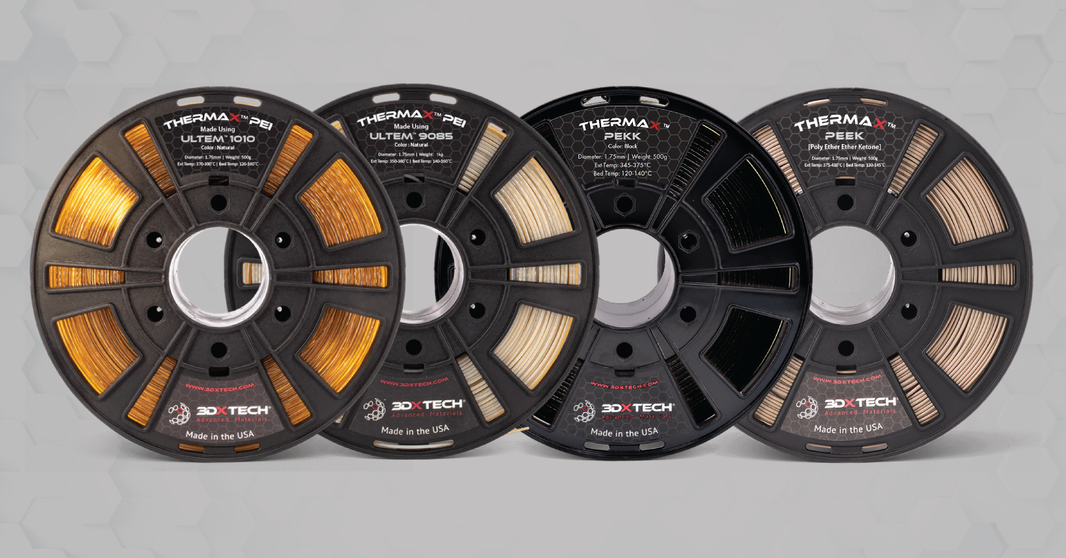High-Performance 3D Printing Filaments for Aerospace & Defense
How PEEK, PEKK, Ultem™ (PEI), and carbon fiber composites enable lighter, stronger, and more reliable flight-ready parts.
Why Aerospace & Defense Demand High-Performance Filaments
In aerospace and defense, parts must perform under extreme heat, vibration, and chemical exposure while meeting strict safety requirements. That’s why engineering polymers like PEEK, PEKK, Ultem™ (PEI), and carbon fiber-reinforced composites are preferred for aerospace 3D printing.
- Weight reduction: Replace metals to improve payload efficiency.
- Thermal stability: Continuous service above 150 °C (material dependent).
- Flame retardancy & compliance: Materials available that meet FST and UL94 V-0 requirements.
- Chemical resistance: Withstand jet fuel, hydraulic fluids, lubricants, and de-icers.
Top Materials for Flight-Ready Applications
PEEK (Polyether Ether Ketone)
PEEK filament combines a high strength-to-weight ratio with outstanding chemical resistance. It’s used for lightweight brackets, engine-bay components, and satellite housings.
- Typical Tg: ~143 °C; continuous use up to ~250 °C (application dependent).
- Excellent resistance to jet fuel and hydraulic fluids.
PEKK (Polyether Ketone Ketone)
PEKK filament offers similar thermal/chemical performance to PEEK with easier printability and smoother finishes (slower crystallization). Ideal for connectors, ducts, and dimensionally precise housings.
Ultem™ (Polyetherimide, PEI)
Ultem™ (PEI) is naturally flame-retardant and widely used for cabin interior components, electrical enclosures, and panels. Many grades support FST needs in aerospace.
Carbon Fiber-Reinforced Blends
Carbon fiber composites increase stiffness and heat deflection temperature while minimizing weight—perfect for UAV frames, instrument mounts, and tooling.
Printing Considerations
- High-temperature hardware: Nozzle >350 °C, bed up to 160 °C, actively heated chamber recommended for PEEK/PEKK/PEI.
- Moisture control: Dry filament before and during printing to avoid porosity and weak layer bonding. Check out our Filament Dryer and Filament Maintainer.
- Post-processing: Annealing can improve crystallinity for higher thermal stability and strength.
- Quality & traceability: For regulated environments, documentlot traceability, test data, and repeatable process parameters.
Real-World Aerospace & Defense Applications
- Cabin interiors: Ultem™ and PEKK for panels, air ducts, and seat components.
- UAV & drone structures: Carbon fiber composites for lightweight frames.
- Satellite components: PEEK/PEKK housings and brackets designed for thermal cycling.
- Custom tooling & fixtures: Heat-resistant jigs for MRO workflows.
How to Choose the Right Filament
- Temperature envelope: Cabin vs. engine bay vs. near-space/orbital exposure.
- Weight targets: Identify metal-to-polymer substitution opportunities.
- Compliance needs: Validate FST / UL94 V-0 and any program-specific requirements.
- Production plan: Prototype to end-use parts—ensure material availability and repeatable process windows.
Recommended Products
- PEEK Filament — maximum heat/chemical resistance for mission-critical parts.
- PEKK Filament — high performance with improved printability.
- Ultem™ (PEI) Filament — flame-retardant and FST-oriented interior solutions.
- Carbon Fiber Composites — stiffness and weight savings for structures and tooling.






